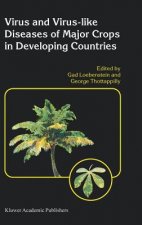
Kod: 01975257
The History of Allelopathy
Autor R.J. Willis
Allelopathy is the study of the chemical interactions of plants. This concept has been known since antiquity, and first appears unambiguously in written form in about 350 B.C. in the works of Theophrastus. This book provides a det ... więcej
- Język:
 Angielski
Angielski - Oprawa: Miękka
- Liczba stron: 316
Wydawca: Springer Netherlands, 2010
- Więcej informacji o książce

Zobacz książki o podobnej tematyce
-

Harry Potter and the Chamber of Secrets: MinaLima Edition
110.20 zł -28 % -

How to Build a Car
140.92 zł -12 % -

Coraline
34.64 zł -14 % -

The Soviet Chess Primer
87.73 zł -10 % -

Fontainebleau Fun Bloc
184.54 zł -15 % -

Fairy Tail 2
37.77 zł -26 % -

What Every BODY is Saying
85.62 zł -5 % -

Warriors Super Edition: Bramblestar's Storm
42.70 zł -23 % -

The Basketball Diaries
73.63 zł -5 % -

Scientific Advertising
40.49 zł -

Polski Krok po Kroku. Volume 1: Student's Workbook with free audio download
45.83 zł -34 % -

Why Nations Fail
123.29 zł -15 % -

Walden
38.27 zł -23 % -

Blood on the Tracks 5
57.51 zł -5 % -

Bulletproof Diet
113.42 zł -5 % -

Stranger Things: Runaway Max
42.70 zł -23 % -

Functional Programming in Scala
176.99 zł -4 % -

House of Sky and Breath
133.77 zł -4 % -

Valuation, University Edition, Seventh Edition - Measuring and Managing the Value of Companies
423.29 zł -

Master Algorithm
52.37 zł -15 % -

Gnosticism
73.43 zł -4 %
Podaruj tę książkę jeszcze dziś
- Zamów książkę i wybierz "Wyślij jako prezent".
- Natychmiast wyślemy Ci bon podarunkowy, który możesz przekazać adresatowi prezentu.
- Książka zostanie wysłana do adresata, a Ty o nic nie musisz się martwić.
Więcej informacji o The History of Allelopathy
Za ten zakup dostaniesz 503 punkty
 Opis
Opis
Allelopathy is the study of the chemical interactions of plants. This concept has been known since antiquity, and first appears unambiguously in written form in about 350 B.C. in the works of Theophrastus. This book provides a detailed account of the concept of allelopathy as it has occured through the course of botanical literature from the earliest recorded writings to the modern era.§In the ancient world, the negative and positive interaction of plants was expressed within the framework of antipathy and sympathy of things. As such, antipathy and sympathy were more widely understood than generally appreciated, and indeed were assimilated in aspects of culture outside of botany and agriculture. §This book firstly addresses the question of what is allelopathy, as allelopathy is one of these unfortunate terms in ecology that has no unified definition. The book then examines the major episodes in the history of allelopathy: the writings from classical Greece and Rome; mediaeval Arabic, Indian and Chinese work; the advent of printing and promulgation of information in the 16th and 17th centuries; the 18th century and the theory of root excretion; the 19th century and the influence of A.P. de Candolle; the early 20th century and the work of Pickering and the USDA Bureau of Soils; and the years leading to the current era.§The work draws extensively on original sources, and consequently many of the assertions published in relation to the background of allelopathy, are shown to be incorrect, or at best very inadequate. There is a great deal of information presented, in a consolidated or accessible form, for the first time. The book endeavours to set the history of allelopathy within both a scientific and sociological context.With a claim to be the first work to document in detail the history of allelopathy, Willis s text provides an account of the concept of allelopathy as it has occurred through the course of botanical literature from the earliest recorded writings to the modern era. A great deal of information is presented here in a consolidated and accessible form for the first time. The book offers a unique insight into the historical factors which have influenced the popularity of allelopathy.Allelopathy is the study of the chemical interactions of plants. This concept has been known since antiquity, and first appears unambiguously in written form in about 350 B.C. in the works of Theophrastus. This book gives a detailed account of the concept of allelopathy as it has occurred through the course of botanical literature from the earliest recorded writings to the modern era.§In the ancient world, the negative and positive interaction of plants was expressed within the framework of antipathy and sympathy of things. As such, antipathy and sympathy were more widely understood than generally appreciated, and indeed were assimilated in aspects of culture outside of botany and agriculture.§This book firstly addresses the question of what is allelopathy, as allelopathy is one of these unfortunate terms in ecology that has no unified definition. The book then examines the major episodes in the history of allelopathy: the writings from classical Greece and Rome; mediaeval Arabic, Indian and Chinese work; the advent of printing and promulgation of information in the 16th and 17th centuries; the 18th century and the theory of root excretion; the 19th century and the influence of A.P. de Candolle; the early 20th century and the work of Pickering and the USDA Bureau of Soils; and the years leading to the current era.§The work draws extensively on original sources, and consequently many of the assertions published in relation to the background of allelopathy, are shown to be incorrect, or at best very inadequate. There is a great deal of information presented, in a consolidated or accessible form, for the first time. The book endeavours to set the history of allelopathy within both a scientific and sociological context.
 Szczegóły książki
Szczegóły książki
Kategoria Książki po angielsku Technology, engineering, agriculture Agriculture & farming Pest control
863.72 zł
- Pełny tytuł: The History of Allelopathy
- Autor: R.J. Willis
- Język:
 Angielski
Angielski - Oprawa: Miękka
- Liczba stron: 316
- EAN: 9789048170395
- ISBN: 9048170397
- ID: 01975257
- Wydawca: Springer Netherlands
- Waga: 473 g
- Wymiary: 240 × 160 × 17 mm
- Rok wydania: 2010
Ulubione w innej kategorii
-

Plant Pathology and Plant Pathogens, Fourth Edition
571.28 zł -

How to Get Rid of Garden Pests and Diseases
33.64 zł -23 % -

Integrated Pest Management
270.17 zł -10 % -

RHS Can Anything Stop Slugs?
70.41 zł -23 % -

Nicotinoid Insecticides and the Nicotinic Acetylcholine Receptor
1122.01 zł -

Pest Control Simplified for Everyone
144.15 zł -

Non-Chemical Weed Control
221.41 zł -5 % -

Pesticide Application Methods 4e
888.20 zł -3 % -

Modern Crop Protection Compounds 3e
2850.78 zł -

Mites (Acari) for Pest Control
2160.32 zł -

Insect Pest Management
868.66 zł -

Plant Pathology and Plant Pathogens
544.88 zł -

Biodiversity and Pest Management in Agroecosystems
420.07 zł -

Pests in Houses Great and Small
91.66 zł -

Herbicide Resistance and World Grains
1256.50 zł -

Introduction to Plant Diseases
285.78 zł -

Integrated Pest Management
1122.01 zł -

Biofouling Methods
865.03 zł -3 % -

Integrated Tse-tse Fly Control
1017.55 zł -

Natural Control of Garden Pests
77.76 zł -22 % -

International code of conduct on pesticide management
60.94 zł -

Model Business Plan for a Sterile Insect Production Facility
207.41 zł -

Regulating Pesticides in Food
451.30 zł -

Weed Biology and Climate Change
971.51 zł -

Great Gypsy Moth War
218.89 zł -

Fruit Fly Pests
1077.28 zł -

Virus and Virus-like Diseases of Major Crops in Developing Countries
1122.01 zł -

The History of Allelopathy
868.66 zł -

New Approaches to the Economics of Plant Health
1122.01 zł -

Basic and Applied Aspects of Biopesticides
868.66 zł -

Classical Biological Control of Bemisia tabaci in the United States - A Review of Interagency Research and Implementation
564.63 zł -

International Code of Conduct on Pesticide Management
74.13 zł -

Climate variability and change
146.56 zł -

Pesticide Policy, Production Risk, and Producer Welfare
716.74 zł -

Macadamia Integrated Pest Management
94.89 zł -

Whitewash
128.94 zł -7 % -

Nano-Biopesticides Today and Future Perspectives
965.46 zł -

Temperature Sensitivity In Insects And Application In Integrated Pest Management
241.06 zł -

Chlorinated Insecticides
270.37 zł -

Greenhouse Pest Management
1047.36 zł -

Target Sites of Herbicide Action
3436.77 zł -

Application Technology for Crop Protection
699.72 zł -10 % -

Nematodes as Biocontrol Agents
747.97 zł -9 % -

American Pests
174.57 zł -4 % -

Plant Nematodes of Agricultural Importance
629.20 zł -

Herbicides and Plant Physiology
403.75 zł -

Heat Treatments for Postharvest Pest Control
1193.94 zł -

Fungicide Resistance in Crop Protection
1088.06 zł -

Pesticide Chemistry
1126.85 zł
zadowolonych klientów
Od roku 2008 obsłużyliśmy wielu miłośników książek, ale dla nas każdy był tym wyjątkowym.
Copyright! ©2008-24 libristo.pl Wszelkie prawa zastrzeżonePrywatnieCookies



 21 milionów książek
21 milionów książek Dostawa 10.99 zł
Dostawa 10.99 zł (32) 444 93 66 (8-15.30h)
(32) 444 93 66 (8-15.30h)